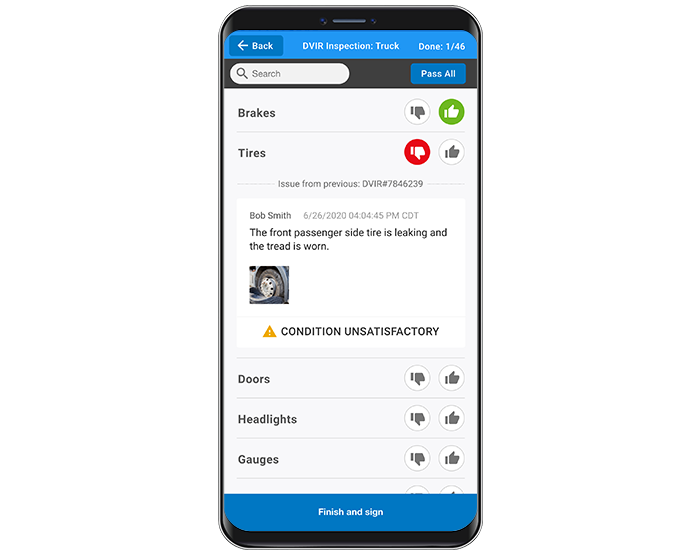Lose the clipboard
The Future of Driver Vehicle Inspection Reporting
Omnitracs Driver Vehicle Inspection Reporting Benefits
Customize visibility
Configure reports per asset type, stop type, driver, and location
Keep teams informed
Send helpful notifications to drivers and maintenance staff
Widen driver potential
Help drivers receive self-certification for maintenance performed away from the shop
Omnitracs makes it easy for drivers to fulfill their DVIR requirements on the go. With mobile functionality, drivers can manage vehicle inspections in real time, allowing them to:
- Conduct walk-around inspections
- Document issues as they arise
- Access complete vehicle inspection histories
- Submit reports as soon as inspections are completed
Additional benefits include:
- Real-time alert notifications
- Full inspection report history
- Driver self-certification of maintenance performed outside the shop
- Walk-through checklists for guided inspections
- On-duty status validation for inspection completion
- Asset-type categorization for easier management
Omnitracs helps streamline trip management, improve driver satisfaction, and reduce costs across fuel, maintenance, and operations. By improving compliance scores and simplifying workflows, Omnitracs helps carriers meet safety regulations more effectively for a safer and more productive fleet.
What is a Driver Vehicle Inspection Report (DIVR)?
The Driver Vehicle Inspection Report (DVIR) is a mandatory requirement for commercial drivers, enforced by the Federal Motor Carrier Safety Administration (FMCSA). This daily report helps ensure that all commercial vehicles are inspected for any potential safety concerns or mechanical issues before being driven on public roads.
Drivers use the DVIR to document any defects or deficiencies they discover that could impact the safe operation of the vehicle. By completing this inspection at the end of each workday, companies can be confident that issues are identified and addressed quickly, keeping vehicles roadworthy and compliant with federal safety regulations.
Who Fills out the DIVR?
The driver is responsible for completing the DVIR. This regulation applies to most commercial drivers, including those operating vehicles that:
- Have a gross vehicle weight rating or gross combination weight rating of 4,537 kg (10,001 lb) or more.
- Are designed or used to transport 9 to 15 passengers (including the driver) for compensation.
- Are designed or used to transport 16 or more passengers.
- Are used for transporting hazardous materials as regulated by the Hazardous Materials Transportation Act.
Which Part Defects Must be Included in the Driver Vehicle Inspection Report?
To ensure a thorough inspection, the DVIR must cover a minimum list of essential parts and accessories, which include:
- Service brakes, including trailer brake connections
- Parking brake
- Steering mechanism
- Lighting devices and reflectors
- Tires
- Horn
- Windshield wipers
- Rear vision mirrors
- Coupling devices
- Wheels and rims
- Emergency equipment
What Happens When Driver Vehicle Inspection Report Rules are Violated?
Failure to comply with DVIR regulations can result in serious consequences for both drivers and carriers. Non-compliance may lead to citations, penalties, and points added to the carrier's safety rating. What's more, if an accident occurs and it is determined that the lack of proper inspection contributed to the incident, both the driver and the carrier may face liability, including exposure to nuclear verdicts.
Fines for DVIR violations can range from $1,270 per day to over $15,000, depending on the severity of the violation. Additionally, vehicles and drivers may be placed out of service if a defect or deficiency is found during a roadside inspection, leading to lost revenue, potential service delays, and reduced compliance scores.
Note: In the U.S., drivers are not required to complete a report if no defects or deficiencies are found, though it's considered a best practice to do so. In Canada, however, a report must be filled out regardless of whether any issues are identified.
